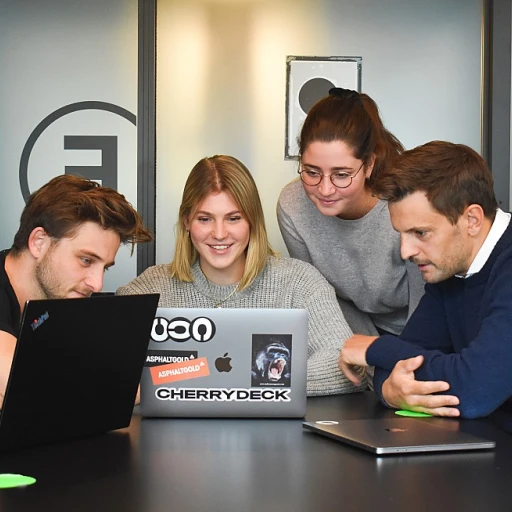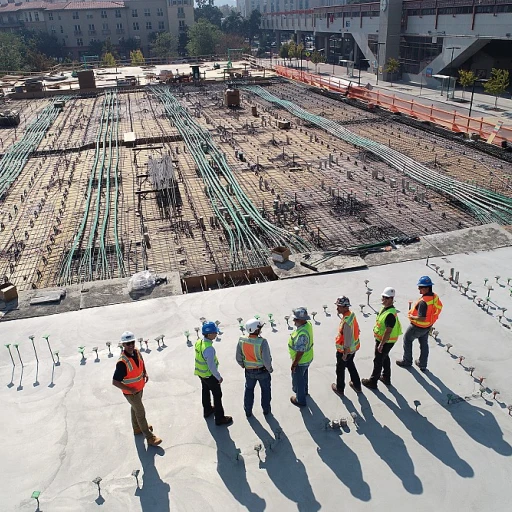
Understanding the Importance of Problem Solving Skills
The Critical Role of Problem Solving in Student Development
In today's fast-paced world, equipping students with problem-solving skills is more crucial than ever. As high school students embark on their academic journeys, developing these skills is imperative to help them navigate complex situations both in and out of the classroom. Engaging them in problem-solving activities not only enhances their learning experience but also prepares them for real-world challenges.
Critical thinking and decision making are at the heart of effective problem solving. These skills encourage students to analyze situations, consider multiple solutions, and make reasoned judgments. By fostering these abilities early on, we can guide students towards becoming effective decision-makers and leaders in their future careers.
Schools are adopting diverse activities to promote problem solving. These range from solving math problems to participating in escape room challenges that sharpen critical thinking. Students engage in these activities both individually and socially, improving their confidence and social skills.
With the flexibility and creativity of role play, students can approach conflicts and find solutions that enhance their social emotional learning. Fun activities like these not only fill the need for engaging problem-based learning, but they also stimulate high student interest and retention.
Providing students with opportunities to practice these skills in a supportive environment helps them build resilience and adaptability. As they encounter various school problems, such as group work conflicts or personal challenges, their ability to address them with confidence and creativity increases.
Types of Problem Solving Activities
Exploring Diverse Problem Solving Activities
Problem solving activities are essential in developing critical thinking and decision-making skills among high school students. These activities not only help students tackle academic challenges but also prepare them for real-world problems. Let's delve into some engaging problem solving activities that can be integrated into a lesson plan to enhance learning and social skills.
Math-Based Challenges
Math-based problem solving activities are a great way to fill students' minds with logical thinking. These activities can range from simple puzzles to complex equations that require critical thinking. By incorporating math problems into the curriculum, students can improve their analytical skills and learn to approach problems methodically.
Role Play and Social Scenarios
Role play is an effective method for teaching social skills and conflict resolution. By simulating real-life scenarios, students can practice emotional learning and develop empathy. This activity helps students understand different perspectives and work towards finding solutions collaboratively. For more insights on conflict resolution, you can explore conflict resolution in team management.
Escape Room Challenges
Escape room activities are a fun and engaging way to promote teamwork and problem solving. These activities require students to work together to solve puzzles and find solutions within a set time limit. This not only enhances their problem solving skills but also fosters a sense of camaraderie and social interaction.
Project-Based Learning
Project-based learning allows students to tackle real-world problems through collaborative work. By engaging in projects that require research, planning, and execution, students can develop a deeper understanding of the subject matter. This approach encourages creativity and innovation, making learning more dynamic and impactful.
Incorporating these diverse problem solving activities into the school curriculum can significantly enhance students' critical thinking and decision-making abilities. These activities not only make learning fun but also prepare students for future challenges.
Incorporating Technology in Problem Solving
Integrating Technology for a Modern Solution
In today's digital age, technology has become a cornerstone in fostering engaging problem-solving activities for high school students. Leveraging technology not only appeals to students' inherent interest in gadgets and software but also enhances their critical thinking and decision-making capabilities. By incorporating various technological tools, educators can create a dynamic learning environment that promotes social and emotional learning as well. One effective method to integrate technology is by introducing online platforms that offer interactive problem-solving activities. Such platforms often present students with fun and challenging scenarios that make learning enjoyable. Activities like digital escape room games can be especially engaging, requiring students to employ a combination of problem-solving skills, critical analysis, and collaboration to progress. Furthermore, technology can facilitate personalized learning experiences. Adaptive learning software can adjust the difficulty of problems based on individual student performance, ensuring that everyone is challenged appropriately without feeling overwhelmed. This can help students build their confidence and enhance their social emotional skills as they successfully solve increasingly complex problems. Incorporating technology also includes utilizing apps designed for collaborative problem-solving. These tools encourage students to work together effectively, enhancing their social skills and ability to resolve conflicts. Apps that focus on project-based learning can help students simulate real-world problems and devise solutions, providing them with a practical understanding of the lesson plan concepts they cover. To ensure the effective use of technology, educators must remain updated on the latest applications and digital resources. Providing professional development opportunities for teachers can help them stay equipped to guide students in harnessing technology for enhanced learning outcomes. For more insights on how to engage students with problem-solving activities, consider exploring essential questions to engage your mentee effectively. With careful planning and execution, incorporating technology into problem-solving activities can lead to significant improvements in students' problem-solving capabilities and prepare them for future challenges.Collaborative Problem Solving Techniques
Fostering Teamwork Through Collaborative Activities
Collaborative problem solving is a vital component in developing high school students' critical thinking and social skills. By working together, students learn to communicate effectively, share diverse perspectives, and arrive at solutions that might not be possible individually. These activities not only enhance problem solving skills but also prepare students for real-world scenarios where teamwork is essential.
One effective method is the use of role play scenarios. In these activities, students are assigned different roles within a given problem context. This approach helps them understand various viewpoints and encourages empathy, a crucial social skill. For instance, in a conflict resolution exercise, students can take on roles of different stakeholders, allowing them to explore and negotiate solutions collaboratively.
Interactive and Engaging Problem Solving
Incorporating escape room activities into the classroom can make problem solving fun and engaging. These activities require students to work together to solve puzzles and riddles within a set time limit. Such tasks not only make learning enjoyable but also help students develop decision making and critical thinking skills under pressure.
Another collaborative technique is the use of project-based learning. This method involves students working in groups to tackle real-world problems, integrating knowledge from various subjects like math and social studies. Through this approach, students learn to apply their academic skills in practical situations, enhancing their problem solving abilities.
Building a Supportive Learning Environment
Creating a supportive environment is crucial for effective collaborative problem solving. Teachers can help students by providing clear instructions and setting expectations for group work. Encouraging open communication and respect among students fosters a positive atmosphere where everyone feels free to contribute ideas.
To assess the effectiveness of these activities, educators can observe group dynamics and the solutions students propose. Feedback sessions can also be beneficial, allowing students to reflect on their experiences and identify areas for improvement. By addressing challenges and celebrating successes, teachers can help students build confidence in their problem solving skills.
Assessing Problem Solving Skills
Evaluating Problem Solving Skills in High School Students
Assessing problem solving skills in high school students is crucial to ensure they are developing the necessary critical thinking and decision making abilities. These skills are not only vital for academic success but also for real-world applications. Here are some effective ways to evaluate these skills:
- Project-Based Assessments: Engaging students in project-based activities allows them to apply their problem solving skills in a practical context. This method helps educators observe how students approach problems, develop solutions, and work collaboratively.
- Role Play and Simulations: These activities provide a dynamic way to assess students' social skills and emotional learning. By placing students in hypothetical scenarios, teachers can evaluate their ability to navigate social problems and conflicts.
- Math and Logic Puzzles: Incorporating math-based puzzles and logic problems into the curriculum can help assess students' analytical thinking and problem solving capabilities. These activities are not only fun but also challenge students to think critically.
- Escape Room Challenges: These engaging problem solving activities require students to work together to find solutions under time constraints, fostering both teamwork and critical thinking.
To effectively assess these skills, it's important to provide feedback that helps students understand their strengths and areas for improvement. This feedback should be constructive and aimed at encouraging further development of their problem solving abilities.
Challenges and Solutions in Implementing Problem Solving Activities
Overcoming Hurdles in Problem Solving Activities
Effectively engaging high school students in problem solving activities is not without its challenges. However, by identifying these barriers and implementing strategic solutions, educators can enhance students' learning experiences. Admittedly, the integration of problem solving in lesson plans can be hindered by lack of resources, varying skill levels among students, and resistance to new methodologies. But these obstacles can be addressed with thoughtful planning and execution.- Resource Allocation: Schools often face constraints in providing necessary materials or technology-based solutions for effective learning. By utilizing free online resources and platforms, educators can offer high school students a range of fun and engaging activities that don’t overwhelm school budgets.
- Diverse Skill Sets: Within any group of students, skill and confidence levels can vary significantly. It’s crucial to employ differentiated instruction techniques, adapting activities to cater to different levels. This approach not only helps students improve their problem-solving skills but also fosters an environment of inclusion.
- Resistance to Change: Some students and teachers might hesitate to transition from traditional activities to more interactive or technology-driven ones. Encouraging small group work or social learning exercises can gradually build acceptance, as students experience the benefits of enhanced critical thinking and social skills first-hand.
- Evaluation of Skills: Assessing problem solving skills can be challenging without a standardized method. To ensure accurate assessment, educators can utilize a variety of tools such as escape room activities or role play exercises that naturally incorporate decision-making and conflict resolution.












